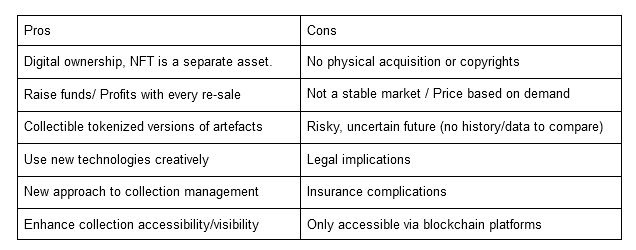Let’s talk about NFTs
If you are unfamiliar with NFTs, they stand for Non-fungible-tokens. Each token is one of a kind and irreplaceable sequence of code with a digital signature. The programming resembles that of cryptocurrency, and they are digital representations of absolutely anything stored on a blockchain. They can be created and sold by anyone.
NFTs play on the idea that you can buy ownership. This, however, does not give you the copyrights to reproduce the work in any way. So, what do you own in the first place? I suppose people buy NFTs in the hopes of reselling for profit, despite the market being so unpredictable and unstable. It could also be the excitement of new technology and the experience of owning or viewing an NFT up close.
It started as a fun new trend, yet they are treated as digital assets. This raises the question, are they art? The simple answer is yes. They technically fall under the digital art category, but they definitely push the limits of what art is. In theory, if anything is art, then why not NFTs. Even though some are screenshots of tweets or digital copies of anything that already exists. If someone values them enough and is willing to pay, then why not! At the end of the day, it comes down to cultural values and maybe even generational or personal values:
- Some people seem to value NFTs enough to invest in them and go as far as to view them as the future of contemporary art and collecting.
- Others value artworks in a more traditional sense, where they can physically see them, so they refuse to believe NFTs are anything other than fakes and a scam.
NFTs can never replace art in the traditional sense, but they have the potential to be an extension of it. The pandemic forced a digital reinvention on the entire world, so NFTs could be the natural evolution of art investment and collection. Cultural institutions and heritage sites experienced a dramatic decline in donations and museum visitors in 2021. This highlighted the need for a digital presence and virtual engagement in bold. Museums post-pandemic rely on online communities as much as they rely on visitor numbers. So if the entire world is moving towards a more digitally-driven lifestyle, what is stopping museums from upgrading too? NFTs could be used just like any other collectable in a museum shop, which could create enough revenue, to prevent the last-resort sales of collection artefacts.
Cultural institutions worldwide have already started selling NFTs based on their collections. Namely, the Uffizi Galleries sold Michelangelo’s Doni Tondo NFT for $170,000. The State Hermitage Museum has auctioned five NFT copies from its masters collection, including Da Vinci’s Madonna Litta, for a total of $444,000. The Whitworth gallery used Blake’s The Ancient of Days NFT in a major exhibition and research project. Finally, the British museum has sold NFTs of 20 Turner paintings and 200 Hokusai works from its collection alongside each temporary exhibition. Even went a step further by creating editions with a certificate of authenticity and categorising them as follows: Ultra Rare, editions of two, one of which will belong to the British Museum, Super Rare, editions of 10, one of which again belongs to the museum and Open Edition, editions of 99.

Such use of NFTs by cultural institutions gives them some cultural validity. This has caused mixed reactions by the public. Yes, museums are marketing digital renditions of artworks already available to the public for profit, but this is the same as selling physical copies or even merchandised versions of artwork. NFTs are just like any other reproduction. They are not marketed or sold as the real thing. They may be more about raising money rather than public engagement or public access, but imagine the possibilities if the profits are being put back into the collection. In particular, imagine if there were no budget guidelines for conservation and preservation.
Our take
The 21st century is an ever-evolving digital age, so art collections moving digital seems like the natural evolution of art. NFTs are becoming part of our digital heritage now. Maybe each token could one day be considered a cultural object. It is only natural to be sceptical about something so new I definitely am. However, we must explore the endless possibilities of the NFT as an artistic medium. It is fascinating to see museums monetising assets creatively in a way they could not before without losing parts of their collections. Cultural institutions should promote artworks as investment assets while considering all ethical and legal requirements. Why not take advantage of this new technology for as long as NFTs still work and are valued.
I want to learn more:
Uffizi Gallery Turned a Michelangelo Painting Into an NFT and It Sold for $170,000
NFT platform certified by the British Museum
About the author:
Anastasia Papaonisiforou is a London based exhibitions expert with an MA in Curating and Collections and a background in Fine Arts. She is our oldest patron and graciously accepted to cover this topic for Local Approach; she is available to give advice on discord through our “Let’s talk about your heritage!” membership, upon specific request.
More from Anastasia:
Curating: a viewer’s perspective
Curated Reading List series
Exhibition Review: The Making of Rodin
Exhibition Review: Home Galleries and Rooms Through Time
Exhibition Review: Yayoi Kusama: Infinity Mirror Rooms
Our Articles

